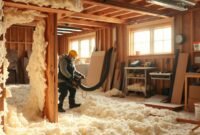Looking to cut costs in your home improvement projects? We’ve devised several creative ways to insulate a shed cheaply and effectively, including spray foam insulation. As the cost of living rises, finding free or low-cost solutions for effective insulation of sheds becomes crucial for saving money and energy and reducing heat loss.
You may have thought about the most cost-effective method of insulating your house. But continue reading if you haven’t considered how to insulate a shed for free.

How to Insulate a Shed for Free
Those who frequently create, work, rest, or work on pottery in our sheds know how chilly they may become during the winter. Your wooden hiding spots won’t fluctuate in temperature if you insulate them.
Read also: Does Fiberglass Insulation Burn?
By adding insulation, you can avoid issues like condensation, moisture, and potential animal infestation. An excellent and economical approach to insulating a shed for free is to utilize materials you already have around the house, such as leftover spray foam insulation or breathable membranes that prevent moisture buildup.
- Ensure That It Is Watertight
Ensuring rain and moisture can’t enter your shed is the most excellent method to safeguard it and the products inside of it. Inspect your barn doors and windows for cracks or missing seals where heat might leak in. It may also get windy under your shed roof. Ensure everything is still in place, and secure loose pieces with nails.
Applying a wood-based sealer to the walls will close up all cracks. This will shield the shed from wind and dampness. To safeguard the goods, you store them in the shed. It is crucial to insulate them. By delaying replacement costs, you can save money in the long run.
Installing one or more vents is a good idea because most medium-sized sheds need good ventilation. Keep a window or shed door open frequently when you’re at home if you don’t want to spend any money.
- Bubble Wrap is a Great Way to Protect the Walls of Your Shed
Retain the bubble wrap from larger purchases, as it can be an excellent type of insulation for your shed walls, alongside other insulation like blown-in cellulose insulation.
Bubble wrap insulation, known for its air-filled pockets, is a cost-effective way to insulate your shed, especially considering the value of stored items and its ability to reduce energy loss.
To fit each post on the shed structure, measure the barn panels and cut the bubble wrap to those measurements. To fasten the bubble wrap to the frame, use a stapler. As there needs to be an air gap to minimize moisture issues, do not clamp or put bubble wrap directly on the cladding.
- Gather Cardboard Boxes to Bolster the Insulation of the Blue Barn Shed’s Gray Doors
We advise you to keep the cardboard boxes so you may utilize them as free insulation alongside other materials like spray foam insulation. Corrugated cardboard is a fantastic insulator, thanks to the air spaces between its layers, and can be combined with other materials to enhance the energy efficiency of your shed.
Remember to use cardboard for walls and roofing rather than floors since it is pretty warm to little hairy critters. It might be a sign of pests if you use it and subsequently discover it has been eaten. To avoid leaks or damp problems, plug gaps in the shed construction because cardboard is porous and will collect water.
Read also: Foam Board Pole Barn Insulation
- Utilize Any Remaining Floor or Attic Insulation
Because we frequently purchase more than we need, most of us have a few extra rolls of insulation left after installing it in the attic. This could include materials like batt insulation or spray foam insulation. Using these leftovers for your shed can be a cost-effective way to enhance energy efficiency and prevent heat loss.
If you concur, figure out how to insulate the shed and utilize the remaining scrolls to their full potential. It’s a good idea to insulate just the pitched roof if there aren’t many.
According to Garden Buildings Direct, about 40% of heat is lost via the roof. ‘Fiberglass insulation is not a rigid product, so be aware that over time, it will lose its shape and degenerate gradually, especially if used vertically,’ the Insulation Superstore’s Rosie Milner claims.
- Spread Out Old Carpets or Rugs on the Floor
Should I insulate the floor of my shed? Absolutely. Start by putting up benches in the barn to preserve your barn flooring and prolong the life of worn-out rugs, offcut carpets, or better-looking rugs. In addition to changing that and insulating the floor, doing so will make it more comfortable to walk on than a hard surface.
Additionally, for roof insulation, using leftover materials like closed-cell foam can help retain heat and prevent the ingress of cold air, making your shed more comfortable during colder months.
Final Takeaway
That is all on “how to insulate a shed for free.” The shed may be utilized as a workshop or a place to keep objects sensitive to cold temperatures during the colder months by adding insulation. With enough insulation, constant heating is unnecessary, as the shed can hold heat throughout the day.


